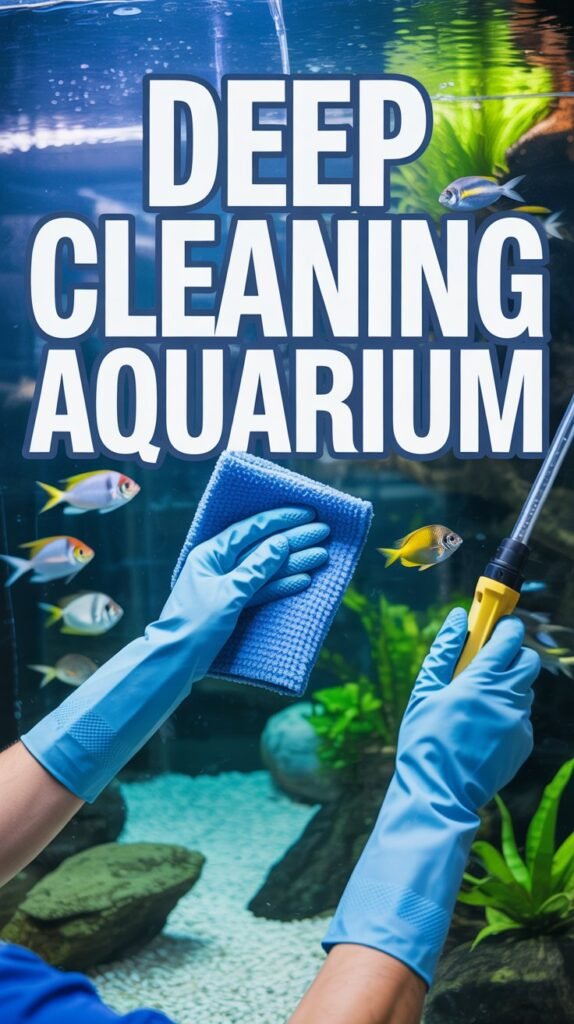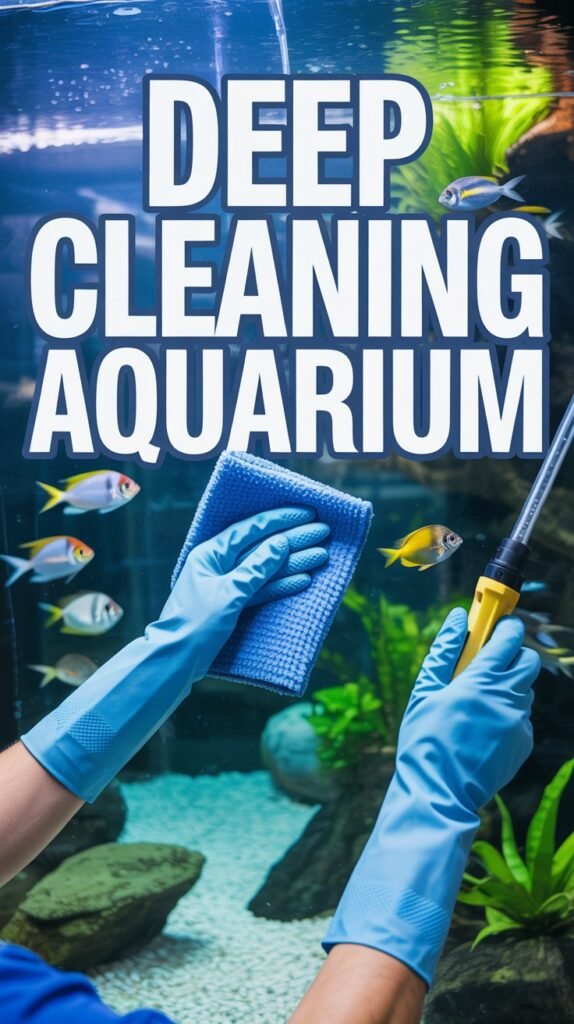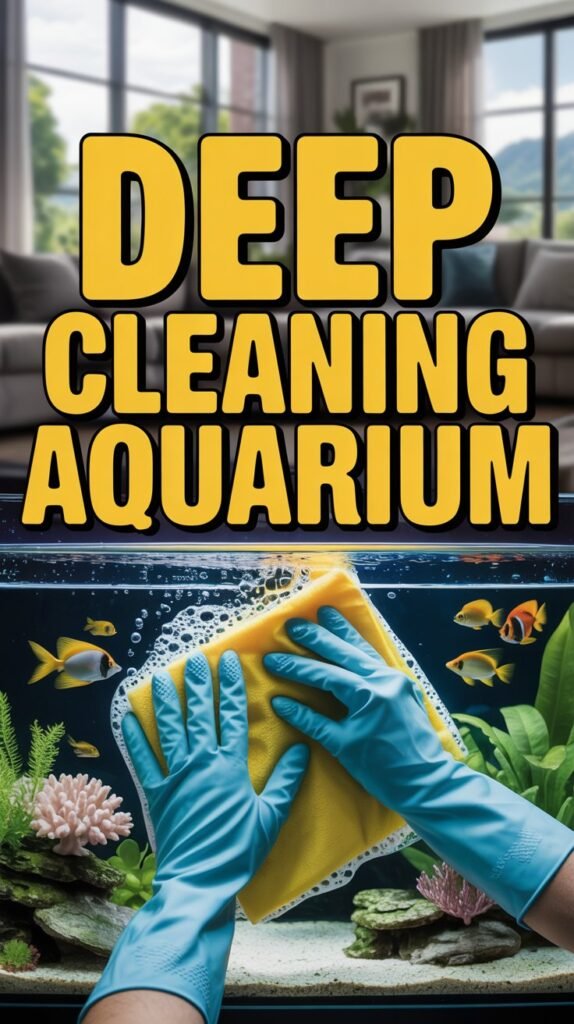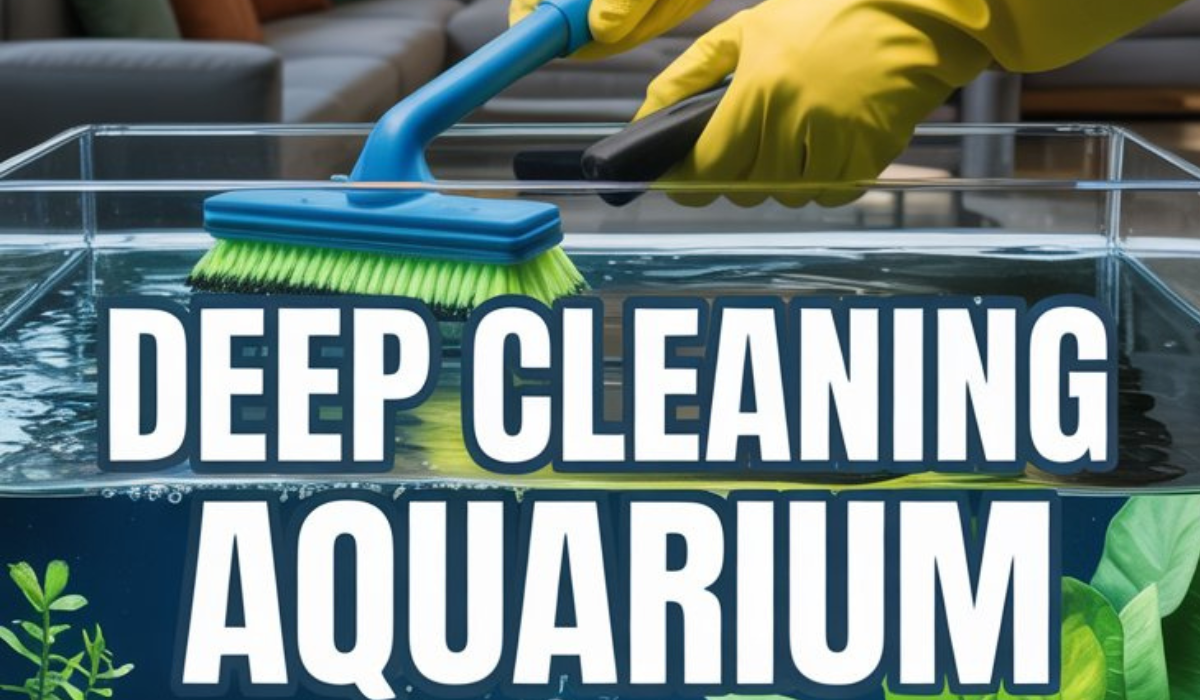Maintaining a clean aquarium is essential for the health and happiness of your fish. Over time, debris, algae, and waste build up even in well-maintained tanks, making deep cleaning an aquarium an important part of aquarium care. A deep clean goes beyond your regular water change — it involves thoroughly cleaning the tank, decorations, substrate, and equipment to restore balance and clarity.
In this comprehensive guide, we’ll walk you through why and how to deep clean an aquarium, the tools you’ll need, step-by-step instructions, expert tips, and how to make the process stress-free for your fish.
1. What Is Deep Cleaning an Aquarium?
Deep cleaning an aquarium means performing a more thorough cleaning than regular maintenance. While weekly tasks like water changes remove surface debris and nitrates, deep cleaning targets the buildup of waste in the gravel, filters, and hard-to-reach spots that accumulate over time.
Key Goals of Deep Cleaning:
- Remove waste and decaying organic matter
- Eliminate stubborn algae buildup
- Clean filters and equipment
- Refresh substrate and decorations
- Restore water clarity and stability
Deep cleaning helps maintain the biological balance of your aquarium, preventing harmful toxins like ammonia and nitrite from rising to dangerous levels.
2. Why Is Deep Cleaning Important?

Even with regular upkeep, waste materials slowly accumulate in your aquarium. Over time, these hidden pollutants can cause serious water quality issues.
Main Benefits of Deep Cleaning:
- Improves Water Quality: Removes detritus and excess nutrients that fuel algae growth.
- Reduces Disease Risk: Clean tanks lower bacterial and fungal infections.
- Restores Oxygen Levels: Cleaner water promotes better oxygen exchange.
- Enhances Aesthetic Appeal: Clear water and sparkling glass showcase your fish beautifully.
- Maintains Biological Balance: Keeps your tank’s ecosystem stable and prevents toxic buildup.
Without deep cleaning, harmful substances such as ammonia, nitrites, and nitrates can accumulate and stress or even kill your fish.
3. How Often Should You Deep Clean an Aquarium?
The frequency of deep cleaning depends on the size of your tank, filtration system, and fish load.
| Aquarium Type | Deep Cleaning Frequency |
|---|---|
| Lightly stocked tanks | Every 2–3 months |
| Moderately stocked tanks | Every 4–6 weeks |
| Heavily stocked tanks | Monthly |
| Planted aquariums | Every 2–3 months (partial cleaning only) |
Over-cleaning can harm beneficial bacteria, so the goal is balance — remove dirt but maintain healthy bacteria colonies.
4. Tools and Supplies Needed for Deep Cleaning
Before you start, gather all the necessary tools. Using the right equipment makes cleaning efficient and safe for your fish.
Essential Tools:
- Aquarium siphon or gravel vacuum
- Buckets (for tank water and waste water)
- Aquarium-safe algae scraper or sponge
- Water conditioner/dechlorinator
- Clean towels
- Filter brush and media cleaning tools
- Aquarium-safe glass cleaner
- Replacement filter media (if needed)
- Test kit (for ammonia, nitrite, nitrate, pH)
Avoid using soap, bleach, or detergents, as these are toxic to fish. Only use aquarium-safe products.
5. Preparing for a Deep Clean
Preparation is key to minimizing stress for your fish and protecting beneficial bacteria colonies.
Steps Before Cleaning:
- Unplug all equipment: Turn off the heater, filter, and air pump.
- Prepare holding container (optional): If you plan to do a major cleaning or scrub decorations, gently move fish into a temporary tank with existing aquarium water.
- Remove decorations and artificial plants: Rinse them separately to avoid clouding the tank.
- Test water parameters: Record ammonia, nitrite, nitrate, and pH levels before cleaning.
By planning ahead, you’ll make the deep cleaning process smooth and efficient.
6. Step-by-Step Guide to Deep Cleaning Your Aquarium

Here’s a complete breakdown of the deep cleaning process — done safely and efficiently.
Step 1: Partial Water Removal
- Use a siphon to remove 30–50% of the aquarium water into a bucket.
- Avoid removing all the water, as it disrupts beneficial bacteria.
- While siphoning, hover the gravel vacuum near the substrate to lift and remove debris.
Pro Tip: Use the old aquarium water to clean filter media and decorations — it preserves helpful bacteria.
Step 2: Clean the Glass and Walls
- Use an algae scraper or magnetic cleaner to remove algae buildup from the glass.
- Clean both the inside and outside of the tank.
- For stubborn algae, use a plastic razor blade (for glass tanks) or a soft sponge (for acrylic tanks).
Avoid household glass cleaners, as they may contain ammonia or chemicals harmful to fish.
Step 3: Clean Decorations and Artificial Plants
- Remove any decorations, stones, or plastic plants.
- Scrub them with an aquarium brush or toothbrush in the old tank water.
- For hard algae buildup, soak them in a 10% bleach solution for 10 minutes, then rinse thoroughly and let them dry before reintroducing them.
Natural driftwood or live plants should not be bleached — rinse gently with tank water instead.
Step 4: Clean the Substrate
- Use the gravel vacuum to thoroughly clean the substrate.
- Move slowly to avoid disturbing beneficial bacteria too much.
- Focus on areas with visible debris or fish waste buildup.
If you have a sand substrate, lightly hover the siphon above it to remove waste without sucking up the sand.
Step 5: Clean the Filter
The filter is the heart of your aquarium, so handle it with care.
- Remove filter media and rinse it in the old tank water (not tap water).
- Clean the impeller, intake tube, and housing with a small brush.
- Replace only part of the filter media at a time to preserve beneficial bacteria.
Pro Tip: Never replace all filter media at once — it can cause a sudden ammonia spike.
Step 6: Clean the Heater and Equipment
- Wipe the heater, thermometer, and other devices with a soft cloth dipped in tank water.
- Remove calcium deposits with vinegar if needed, then rinse thoroughly.
- Inspect cords and seals for wear or cracks.
Step 7: Refill the Tank
- Slowly refill the tank with dechlorinated, temperature-matched water.
- Pour water gently to avoid disturbing the substrate.
- Use a plate or bowl to diffuse the water flow.
Make sure the temperature matches the old water (±1–2°C) to prevent shocking your fish.
8: Restart Equipment
- Plug in the heater, filter, and air pump.
- Check that everything is working properly.
- Observe water flow and ensure the temperature stabilizes.
After 24 hours, retest your water parameters to confirm that ammonia and nitrite levels remain at 0 ppm.
7. Special Considerations for Different Aquarium Types
A. Planted Aquariums
- Avoid deep substrate vacuuming near plant roots.
- Trim dead leaves and clean algae from plant surfaces gently.
- Use a gravel cleaner carefully to preserve root systems.
B. Saltwater Aquariums
- Clean salt creep around tank edges.
- Use a protein skimmer to maintain water purity.
- Test salinity before and after cleaning to ensure consistency.
C. Nano or Small Aquariums
- Perform smaller, more frequent cleanings to avoid sudden changes.
- Always match water temperature carefully to prevent stress.
8. Mistakes to Avoid During Deep Cleaning

Even experienced aquarists can make mistakes that harm the aquarium’s ecosystem. Avoid the following:
- Over-cleaning: Removing all beneficial bacteria can cause ammonia spikes.
- Using tap water on filter media: Chlorine kills bacteria colonies.
- Cleaning everything at once: Clean in stages to maintain balance.
- Skipping dechlorinator: Always treat new water before adding it.
- Rapid temperature change: Can shock and stress fish.
- Using soaps or detergents: Toxic to all aquatic life.
Deep cleaning should improve your aquarium’s health, not reset it completely.
9. How to Minimize Stress on Fish During Deep Cleaning
Fish can get stressed during major maintenance. To reduce their anxiety:
- Move slowly and gently around the tank.
- Keep noise and vibrations to a minimum.
- Avoid chasing or netting fish unnecessarily.
- Maintain stable temperature and pH throughout the process.
- If doing major cleaning, temporarily house fish in a separate container with aeration and heater support.
After cleaning, your fish may hide or act sluggish — this is normal and usually resolves within a few hours.
10. Signs Your Aquarium Needs a Deep Clean
If you’re unsure when to deep clean, look for these indicators:
- Cloudy or greenish water
- Excessive algae on glass and decorations
- Unpleasant odor
- Fish showing signs of stress or gasping at the surface
- Accumulation of debris on the substrate
- Sluggish water flow from the filter
These symptoms signal that waste buildup and poor circulation are affecting the tank’s health.
11. Post-Cleaning Maintenance Tips
To maintain your tank between deep cleanings:
- Perform weekly partial water changes (20–25%).
- Feed sparingly — overfeeding increases waste.
- Clean filter monthly, alternating media cleaning.
- Scrape algae regularly before it becomes thick.
- Test water weekly for ammonia, nitrites, and nitrates.
- Vacuum substrate lightly during water changes.
By combining regular maintenance with periodic deep cleaning, you can keep your aquarium crystal clear and your fish healthy.
12. Benefits of a Deep-Cleaned Aquarium
A freshly cleaned aquarium benefits both fish and aquarists:
- Clearer water and better visibility
- Reduced risk of disease outbreaks
- Enhanced fish coloration and activity
- Improved biological balance
- A more beautiful, stress-free environment
Fish in clean tanks display brighter colors, more natural behavior, and live longer — making deep cleaning a worthwhile effort.
13. Environmentally Friendly Aquarium Cleaning Tips
If you want to keep your cleaning process eco-friendly:
- Reuse tank water to water houseplants (it’s nutrient-rich).
- Use natural cleaners like vinegar for calcium buildup.
- Choose biodegradable sponges and reusable tools.
- Avoid chemical-based cleaners or disinfectants.
An eco-conscious approach benefits your tank and the environment.
14. Professional Deep Cleaning Services
If you have a large or complex setup (especially marine or planted tanks), professional aquarium cleaning services can be a great option.
Why Consider Professional Cleaning:
- Expertise with advanced filtration systems
- Safe handling of sensitive or exotic fish
- Deep cleaning without disrupting biological balance
- Saves time for busy aquarists
Professional cleanings are typically needed every few months for large display aquariums.
15. Conclusion
Deep cleaning your aquarium is one of the best investments you can make in the long-term health of your aquatic ecosystem. While regular maintenance keeps the tank running, a deep clean ensures that no hidden debris, algae, or buildup threatens your fish.
By following a careful, step-by-step cleaning routine — without disturbing beneficial bacteria — you can maintain crystal-clear water, vibrant fish, and a healthy environment. Remember, deep cleaning doesn’t mean starting over; it means refreshing and restoring balance so your aquarium thrives.
A well-maintained, sparkling tank not only keeps your fish healthy but also enhances the beauty of your living space — a true reflection of care and dedication.
FAQs About Deep Cleaning an Aquarium
1. How often should I deep clean my aquarium?
For most tanks, once every 4–6 weeks is ideal. Heavily stocked tanks may need monthly deep cleaning.
2. Should I remove all fish during deep cleaning?
Not always. If you’re only cleaning substrate and decorations, fish can stay in the tank. Move them only if you’re doing a major overhaul.
3. Can I use soap or detergents to clean the tank?
No. Soap is toxic to fish and can leave harmful residues. Use only aquarium-safe tools and water.
4. How much water should I change during deep cleaning?
Remove 30–50% of the water. Never replace all of it, as this disrupts the beneficial bacteria and biological balance.
5. Can I clean my filter during deep cleaning?
Yes, but rinse filter media in old tank water — not tap water — to preserve bacteria colonies.
6. Do I need to clean live plants?
Gently remove algae with a soft sponge or by hand. Avoid using bleach or chemicals on live plants.
7. What should I do if the water turns cloudy after cleaning?
This can happen temporarily due to disturbed debris. It usually clears within 24–48 hours if the filter is functioning properly.
8. Is deep cleaning safe for newly set-up aquariums?
Avoid deep cleaning in new tanks (first 4–6 weeks) as it disrupts the nitrogen cycle. Focus on partial water changes instead.
9. What’s the difference between regular cleaning and deep cleaning?
Regular cleaning involves small water changes and light substrate cleaning, while deep cleaning includes cleaning the filter, decorations, and substrate thoroughly.
10. Can deep cleaning harm beneficial bacteria?
If done excessively or incorrectly, yes. Always keep some old water, clean the filter gently, and avoid using tap water on media.

